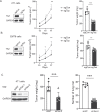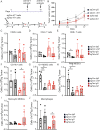Loss-of-function of the hippo transducer TAZ reduces mammary tumor growth through a myeloid-derived suppressor cell-dependent mechanism
- PMID: 35840667
- PMCID: PMC9663307
- DOI: 10.1038/s41417-022-00502-0
Loss-of-function of the hippo transducer TAZ reduces mammary tumor growth through a myeloid-derived suppressor cell-dependent mechanism
Abstract
TAZ, one of the key effectors in the Hippo pathway, is often dysregulated in breast cancer, leading to cancer stemness, survival, and metastasis. However, the mechanistic bases of these tumor outcomes are incompletely understood and even less is known about the potential role played by the non-malignant cellular constituents of the tumor microenvironment (TME). Here, we revealed an inverse correlation between TAZ expression and survival in triple-negative breast cancer (TNBC), but not other subtypes of breast cancer. We found that TAZ knockdown in two murine TNBC tumor cell line models significantly inhibited tumor growth and metastasis in immune competent but not immune deficient hosts. RNA-seq analyses identified substantial alterations in immune components in TAZ knockdown tumors. Using mass cytometry analysis, we found that TAZ-deficiency altered the immune landscape of the TME leading to significant reductions in immune suppressive populations, namely myeloid-derived suppressor cells (MDSCs) and macrophages accompanied by elevated CD8+ T cell/myeloid cell ratios. Mechanistic studies demonstrated that TAZ-mediated tumor growth was MDSC-dependent in that MDSC depletion led to reduced tumor growth in control, but not TAZ-knockdown tumor cells. Altogether, we identified a novel non-cancer cell-autonomous mechanism by which tumor-intrinsic TAZ expression aids tumor progression. Thus, our findings advance an understanding of the crosstalk between tumor-derived TAZ expression and the immune contexture within the TME, which may lead to new therapeutic interventions for TNBC or other TAZ-driven cancers.
© 2022. The Author(s).
Conflict of interest statement
C. Frangou is a consultant/advisory board member for Cellecta, Inc (Mountain View, CA). No potential conflicts of interest were disclosed by the other authors.
Figures





References
Publication types
MeSH terms
Substances
Grants and funding
LinkOut - more resources
Full Text Sources
Research Materials

